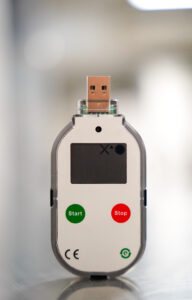
Download this White Paper and explore in-depth insights on the topic, or continue reading the article below.
If you’re involved in clinical trial operations, there’s a good chance that you’ve had to manage a temperature excursion. A typical trial supply chain involves multiple products, temperature ranges and depots. Excursions add further complexity, creating stress and disruption.
This white paper explores what a temperature excursion is, how they occur, how to prevent them and how to mitigate their impact.
Historically, temperature-controlled shipments were less sophisticated, involving simple insulated boxes (and crossed fingers). Monitoring, if used at all, meant a single data logger checked at the end of a shipment. The prevailing approach was reactive, so by the time an excursion was detected, the damage was already done.
Advances in packaging, monitoring, and regulation have transformed the landscape. Today’s supply chains use validated shippers, real-time monitoring, and GPS tracking. Specialist logistics providers can move temperature-sensitive goods almost anywhere in the world.
Products have also evolved. Many products and IMPs must be stored and distributed within strict temperature ranges. Controlled Ambient (15 to 25°C) and Cold Chain (2 to 8°C) are most common, but some materials require frozen storage (-15 to -80°C) with some even needing cryo-storage (below -150°C).
Shipping solutions fall into two categories:

Active – powered refrigeration or HVAC units that maintain temperature indefinitely.

Passive – insulated containers with pre-conditioned coolants, effective for a limited duration.
Choosing between them depends on shipment size, distance, customs barriers, urgency, and value. It can be a difficult choice, but an experienced vendor can advise on the most suitable option. Active solutions maintain temperature indefinitely while passive solutions may need to be replenished or replaced during transit.
A temperature excursion occurs when temperature sensitive product is exposed to an environment outside of its prescribed storage conditions. Most happen in transit, though they can also occur at depots or clinical trial sites.
Portable temperature monitoring devices and built-in vehicle monitors record temperatures during transit. Depots are constantly monitored by fixed devices. Monitors are also known as loggers, recorders, sensors, or probes, and can be programmed with customized high and low alarm limits. The alarm function clearly indicates when an excursion has occurred.

Customs clearance delays, flight cancellations, incorrect or inaccurate shipping documents can all contribute to a temperature excursion. The longer the transit time, the more likely a shipment will drift outside of its desired temperature range.
Receipt, storage, dispatch and transport of medicinal products is directed by an intricate web of Standard Operating Procedures and Work Instructions. As we know, no process is completely infallible. Process failures in general are a prominent cause of temperature excursions.
In fact, most alarms that you are likely to come across will be due to mishandling of boxes or loggers. The below example shows a temperature report where the person receiving did not stop the monitor after delivery, then removed it from the cold store. The proof of delivery and receipting documentation clearly showed this was the case, so the incident was promptly closed, and the product could safely be used.
When an excursion is suspected, it must be logged immediately, the goods quarantined, and an investigation initiated. Rapid access to temperature data and wider shipping information and records helps determine the duration and severity of the event. Your vendor should provide the necessary information and complete their investigations as a matter of urgency, so as not to prolong any delays to distribution.
Product storage requirements (found in the Patient Information Leaflet or Summary of Product Characteristics) outline permitted storage conditions. Some “ambient” products permit wider ranges (e.g. “do not store above 25°C”), meaning alarms may trigger even when the product remains within safe limits. It is important to know and understand exactly what the storage conditions mean.
For tighter ranges, such as 2-8°C, where excursions may happen more frequently, it can help to have stability data. Some manufacturers are able to provide stability data to support brief or minor excursions. Vendors who have extensive experience with certain products often know exactly where to find and obtain supporting data.
Investigators should confirm whether the alarm reflects a genuine excursion or a handling error (e.g. a logger left out during unpacking). Being able to prove that a temperature alarm is unrelated to the temperature of the product itself is the ideal outcome.
Ultimately, the final decision on whether a product remains fit-for-use or not sits with a Responsible Person (RP), or Qualified Person (QP). Before releasing the goods, they must hold clear evidence that the temperature excursion has not compromised the product’s integrity.
Warehouse and logistics operatives must be able to handle goods correctly, identify risks, and stop processes when needed. Simple steps, like providing sites with delivery notifications and logger handling instructions can prevent avoidable incidents.
Equipment and facility maintenance is hugely important in preventing excursions, especially where active temperature controls are involved. Refrigeration units, insulated boxes, and temperature probes must be regularly maintained, mapped, and recalibrated. Multi-use shippers should be requalified at regular intervals and retired when expired or damaged.
Facilities should have generators, backup packaging, and rapid-response procedures in place in case of temperature control failure. Environmental monitoring systems offer real-time remote access to temperatures at a facility, and can issue alerts if temperatures start to drift.
For international shipments, pre-approvals and correct paperwork reduce delays. Specialist providers with brokerage capabilities can expedite clearance. Do you know if your logistics provider can access a shipment to replenish temperature controlled packaging if they need to? Ensuring couriers have access to shipments at airports allows them to quickly recover and replenish temperature controlled packaging if required.
Packaging can guarantee goods stay within a desired temperature range for a specified length of time. Choose packaging rated for the route duration (e.g. 48 hours vs 7 days). A 48-hour box is appropriate for a shipment between two sites in the same country but isn’t going to work for an export from Europe to Australia. For critical shipments, invest in real-time monitoring to enable proactive intervention.
Not every alarm is a true excursion, but the best way to mitigate temperature related risk is to prepare for each and every shipment diligently. Even small errors can create costly delays. For example, a missing temperature monitor in a shipment is an example of an easily avoidable oversight which would have serious consequences.

A sponsor will often outsource most, if not all, aspects of clinical trial storage and distribution. Employing a diligent and responsive vendor is the best way to minimize the frequency and impact of temperature excursions.
Most incidents can be prevented. Good planning and training can prevent:
– Customs delays due to incorrect or incomplete documentation
– Packaging failures or inappropriate temperature controls
– Improper handling of temperature sensitive products and temperature monitors
Other incidents are harder to control, but can be mitigated:
– External customs and border delays
– Transport disruption due to flight cancellations or bad weather
– Equipment failure
Temperature excursions remain among the most disruptive risks in clinical trial logistics, but with the right combination of experienced vendors and proactive incident management, their impact can be minimized. By striking this balance, supply chain managers effectively protect patients and keep studies on track.
To speak to Midwinter about clinical trial logistics, contact me at dan.pritchard@midwinter-solutions.com.
Temperature excursions remain among the most disruptive risks in clinical trial logistics, but with the right combination of experienced vendors and proactive incident management, their impact can be minimized.
By striking this balance, supply chain managers effectively protect patients and keep studies on track.
To speak to Midwinter about clinical trial logistics, contact me at dan.pritchard@midwinter-solutions.com
Sign up to our Mailing List to stay informed of the latest updates and insights.
10 Granary Wharf, Wetmore Road, Burton-upon-Trent, Staffordshire, United Kingdom, DE14 1DU
Global Enquiries: +44 (0)207 477 2229
If you’re committed to excellence and excited to be part of a dynamic, client-focused environment, we’d love to hear from you.